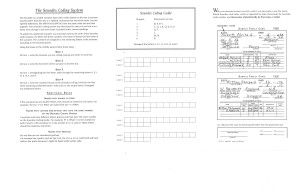Soundex – it hardly exists anymore. But if you are interested in family history, and plan on using census records, or HIAS client files (among other Soundex-coded collections), it can either be annoying or a real time saver.
The National Archives and Records Administration (NARA), which holds the census records, created the Soundex system beginning with the 1880 census. Many of the 1890 census records were destroyed in a fire in 1921 when they were being held by the Department of Commerce; a “small percentage” of some the 1890 records survives in an alphabetical index which does not use Soundex. 1900 and 1920 records are completely searchable using Soundex; 1910 has a Soundex index for about half the states.
NARA observes a 72-year delay in the release of census records (the 72-year rule was mandated by Congress in 1978); by the time the 1930 census was ready for release, in 2002, database software had made Soundex obsolete – except for conducting research with records from 1880 to 1920.
A pamphlet found in the HIAS collection (Administration series, Heather Halliday archivist files, box 121), from NARA, “Census Soundex”, gives the above history and then has several pages on how to use Soundex, pictured below.

What is Soundex and how does it work? The simple explanation is that “Soundex is a coded surname (last name) index based on the way a surname sounds rather than the way it is spelled. Surnames that sound the same, but are spelled differently, like SMITH and SMYTH, have the same code and are filed together … you can find a surname even though it may have been recorded under various spellings.”
Anyone who has done much family history research can tell you that the variant spellings as names originating in other countries changed once in the United States, and is a common problem when hunting down relatives. Soundex is even more helpful when the various spellings of a last name include examples that are spelled with different first letters. Because census records were searched for many years using microfilm, searching throughout the alphabet was incredibly time-consuming.
HIAS developed their own version of the NARA Soundex system, because so many names were Eastern European and there was a need to accommodate certain letters. According to Appendix A in “Genealogical Resources in New York”, edited by Estelle Guzik, the NYC Health Department for the most part used the NARA system.The HIAS Soundex Filing System differs from the NARA system in small ways that have proved helpful to the staff in HIAS’ Location Department. With thousands and thousands of client files, filed by last name and created over decades, being able to locate all the versions of a particular surname in one place was helpful – both in the paper files in their vast Hall of Records, and later (even now) on microfilm.


Some of the HIAS Arrival Cards were scanned from the microfilm to provide the 1955-1980 data for the database created as part of this archives project, which we’ve mentioned before. (Another post here) If you haven’t had a chance to search for family members who were brought to the United States by HIAS from about 1955 to 2000, please try a search. Because ultimately, the goal of all these systems is to find what you’re looking for.